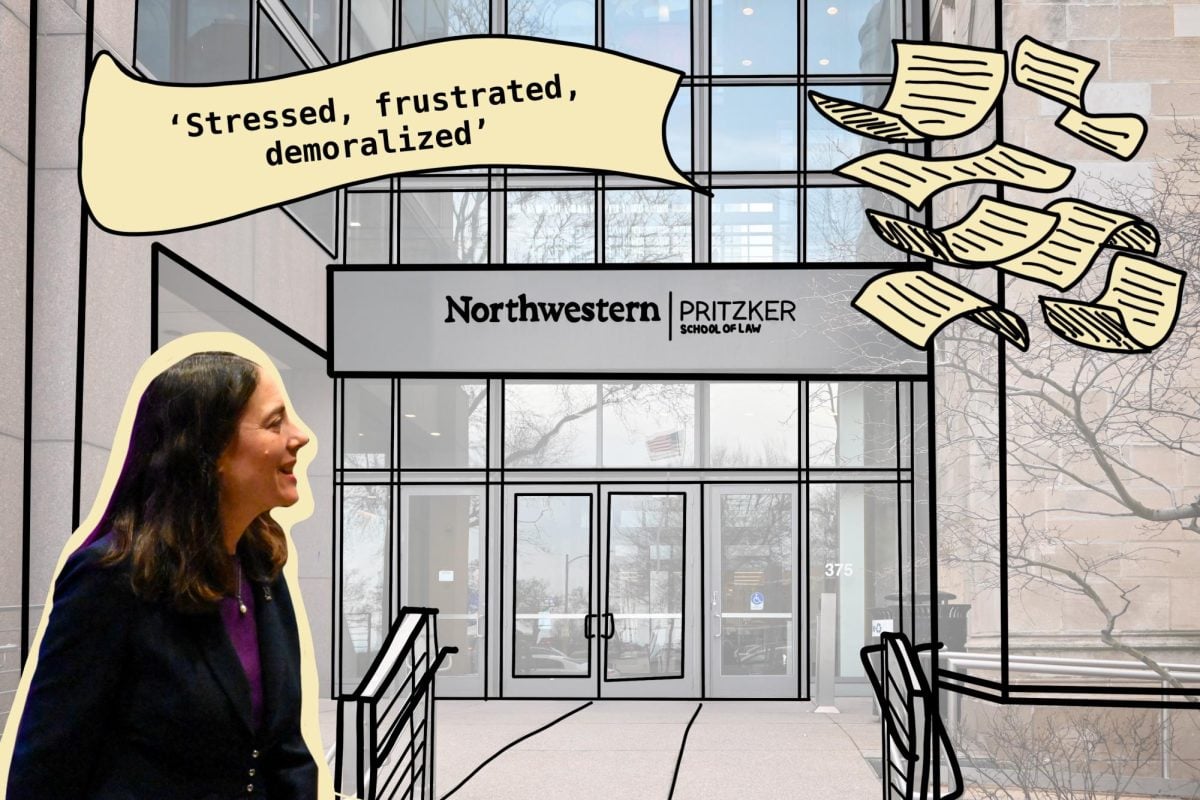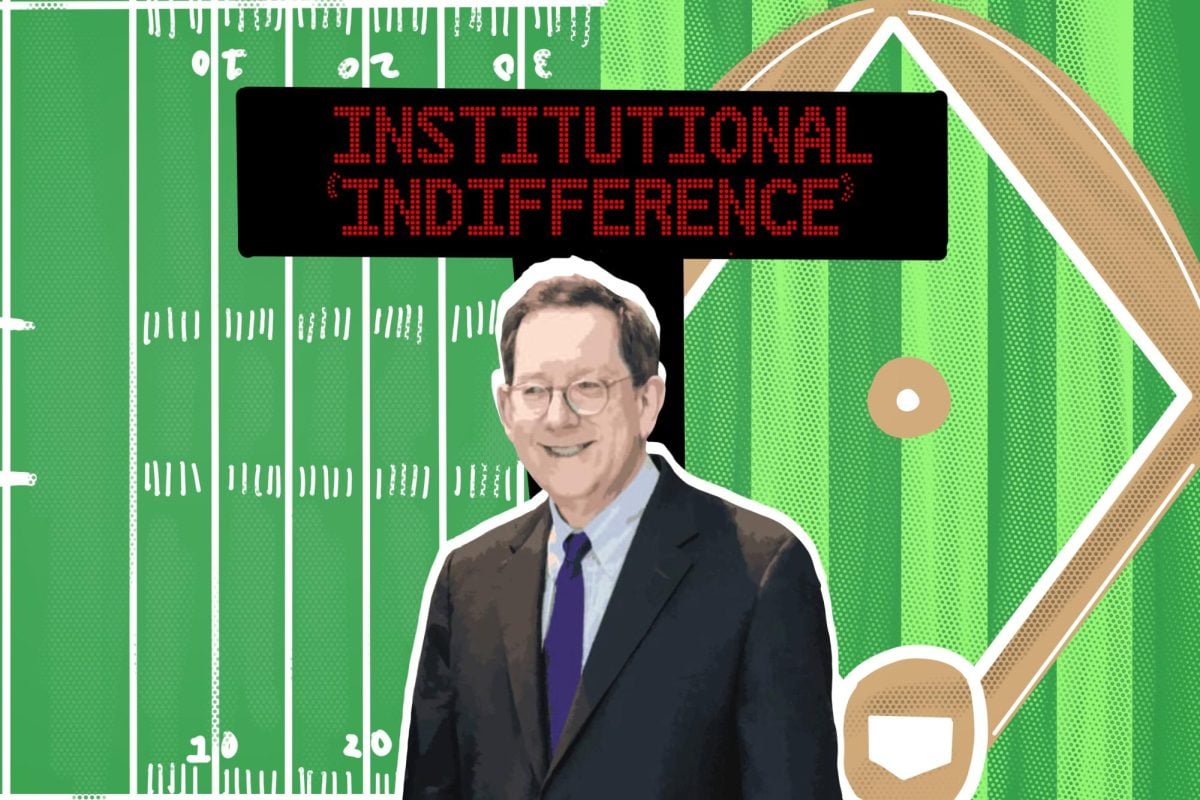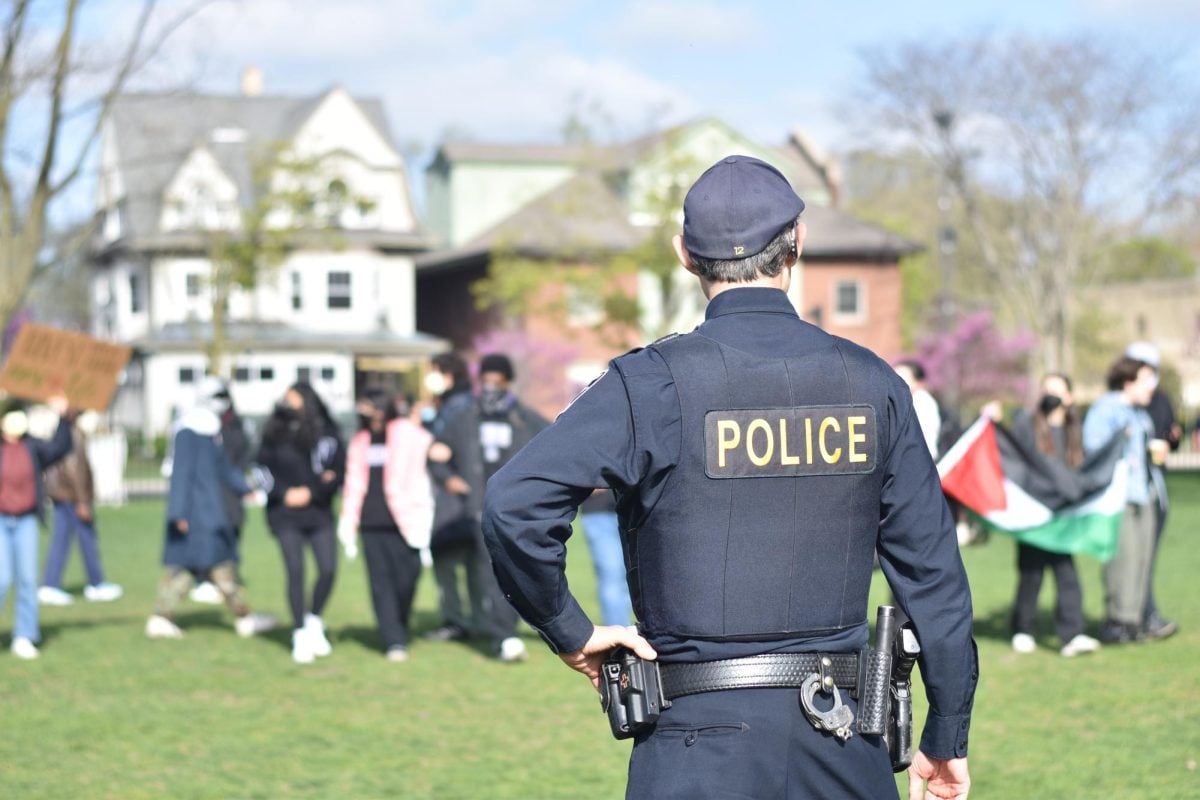 Northwestern did not celebrate “Founders’ Day” this year.
Northwestern did not celebrate “Founders’ Day” this year.
Instead, officials called NU’s 162nd anniversary a “birthday,” in an attempt to appease a group of students who associate the school’s founding with a much more violent moment in American history: the 1864 Sand Creek Massacre.
Whether the tragedy is directly part of NU’s history, however, remains in dispute.
The Native American and Indigenous Student Alliance, is pushing for the University to acknowledge NU founder John Evans’ role in the massacre. Considered one of the most brutal Native American genocides in U.S. history, the attack by federal soldiers resulted in the slaughter of more than 200 Cheyenne and Arapaho people.
The petition, which has amassed more than 200 signatures, calls on the University to formally recognize Evans’ responsibility for Sand Creek and investigate if his actions against native peoples benefitted NU. The document also requests the creation of a Native American studies program — something faculty have supported for years — the establishment of a Sand Creek memorial and the creation of a scholarship to attract more Native American students to NU.
NAISA partnered with Associated Student Government’s Diversity Committee to help author a resolution, passed at Wednesday’s Senate meeting, supporting NAISA and the investigation into Evans’ past.
“A lot of times with historical events, people tend to try to put them in the past and say it’s not important,” said NAISA co-president Adam Mendel, a Weinberg senior. “But with Sand Creek, the University is directly tied to that event.”
Not everyone is as convinced of Evans’ culpability. Two weeks ago, the University formed a committee to formally examine the history over the next year.
NAISA is still struggling to see eye-to-eye with administrators, whose actions, members say, are resistant to change and not transparent. By not allowing students to participate in the committee’s research, however, officials say they are set on separating Evans’ ties to Sand Creek from the need to create a Native American studies program.
“Let’s get the facts straight first,” said Provost Daniel Linzer, who appointed the committee. “The concern that I had with the petition is that it was assuming it had all the facts and was jumping to a conclusion.”
University President Morton Schapiro told The Daily at the beginning of February he is glad NU is examining the issue.
“Did we benefit from it?” Schapiro said. “What was the ongoing relationship with John Evans? That stuff I’d like to know as president.”
‘Erasing’ the past
NAISA hoped the University would commit to probing Evans’ ties with Sand Creek by Founders’ Day on Jan. 28. Although students were in regular discussion with officials, the group grew frustrated when the University failed to issue a formal statement that week.
NU eventually announced Feb. 14 the formation of the John Evans Study Committee. The seven-person commission, which includes NU professors and Native American scholars from across the country, will explore Evans’ connection to Sand Creek and his later involvement with the University, including whether his monetary contributions to NU came from exploiting Native American peoples.
Heather Menefee, NAISA’s other co-president, said NU has a moral responsibility in not “erasing” the possibility that Evans’ wealth — and NU’s — stems from the mistreatment of Native Americans.
Others agree that NU has effectively covered up the violent past of Evans.
“This university has systematically whitewashed, erased its history,” Gary Fine, a John Evans professor of sociology, said in January. “Our founder had the moral and political responsibility for the Sand Creek Massacre.”
Following Sand Creek, Evans was effectively removed from his post as governor but remained chairman of NU’s board of trustees until 1894. But this, Schapiro said, does not necessarily mean he played an important role at the University following the massacre.
“It wasn’t a board chair like my board chair, with whom I speak every week,” Schapiro said. “In fact, apparently he went years without coming back to campus.”
The committee will compile and present a report to Linzer by June 2014, five months before the 150-year anniversary of the massacre.
A disputed history
NU did not immediately respond to the petition because administrators cited a lack of evidence linking Evans to the massacre, Menefee said. The students, who are independently researching the history and gathering their own evidence, grew frustrated with what Menefee said was officials stalling when they could simply “Google it.”
“The Colorado archives has a whole set of John Evans letters, and they sent us one the other day,” Menefee said. “It was in his handwriting. It was a photocopy of his letter a month before the massacre where he said, ‘Kill all the Indians,’ basically. There’s plenty of this evidence.”
Evans, the primary founder of NU and namesake of Evanston, served as Colorado’s territorial governor when the massacre took place. A powerful railroad tycoon, Evans was instrumental in fostering urban development across the West and Midwest.
According to historical experts, Evans was interested in aiding Western development by forcing Native Americans off Colorado land.
On Nov. 29, 1864, Colonel John Chivington led a 700-man force in the attack on a group of Cheyenne and Arapaho camped along Sand Creek, leading to the deaths of more than 200 Native Americans, the majority of them women, children and the elderly.
Because Chivington was the one to physically lead the attack, some are cautious about condemning Evans.
“There’s no direct evidence of his exact role,” Craig Moore, a representative of the Sand Creek Massacre National Historic Site, told The Daily last spring. “Chivington was the one who bore the responsibility; there’s no doubt about that.”
However, historical documents demonstrate Evans’ avid interest in gaining federal recognition for the Colorado Third Regiment, which led the attack on Sand Creek and was effectively formed to kill Native Americans.
Tom Thomas, project manager of the Sand Creek Massacre National Historic Site, said witness testimony and shoot-to-kill proclamations issued by Evans demonstrate his interest in violently forcing the Native Americans off their land.
“As the leading federal official in Colorado, he bears some responsibility,” Thomas said. “He was the one who beat that drum for war as much as anyone could.”
Yet Gary Roberts, a former history professor at Abraham Baldwin Agricultural College working on a book about Sand Creek, said no historical evidence shows Evans was involved in the planning or execution of the attack.
“I don’t think he has any direct responsibility for it,” Roberts said. “He was actually out of the territory when the incident occurred.”
Still, federal and military investigations following the incident show Evans overstated the presence of a Native American threat to Colorado settlers in seeking authorization for the Third Regiment, leading to him being forced out as territorial governor.
“They singled out John Evans as the biggest liar of them all,” said David Halaas, former chief historian for the Colorado Historical Society. “I think that Evans was simply following the overwhelming general feeling to get rid of the Indians.”
Curricular change comes with controversy
Recent attempts to institute a Native American studies program follow a controversial past in establishing other ethnic studies on campus.
NU’s Asian American Studies Program was born in the aftermath of a 23-day hunger strike in April 1995.
Students on the Asian American Advisory Board led the strike, which began with 17 participants. Accompanied by rallies and back-and-forth between students and administrators, the strike sparked protests at other universities, according to University archives. The program was still not established until 1999.
Menefee likened difficulties in establishing Asian American studies with the challenges NAISA now faces.
“A lot of the top-tier schools have Native studies,” the Weinberg sophomore said. “It’s frustrating to see the amount of resistance that comes up at Northwestern. The fact that we had to hunger strike to get Asian American studies — it’s ridiculous.”
Calls for Native American studies are bolstered by the fact that many other elite institutions, including Yale University, Stanford University, Harvard University and Cornell University, have programs in the area.
Tensions also accompanied the creation of the African American studies department earlier in the 20th century. Following the 38-hour occupation of the Bursar’s Office in May 1968 by students from For Members Only, administrators committed to increasing black studies. The department was officially established in 1972.
Latina and Latino studies also developed out of a combined student and faculty initiative. Founded in 2008, the program is the result of years of meetings among administrators, faculty and members of Alianza, said Weinberg associate dean Monica Russel y Rodriguez.
African American studies Prof. Martha Biondi, who came to NU the year Asian American studies was established, said student initiative helps publicly demonstrate desire for ethnic programs.
“Students have thought of creative ways to organize to demonstrate there’s a need for curricular change,” she said.
Setting realistic goals
Although the University and ASG representatives have expressed support for some of NAISA’s goals, they also note the magnitude of what the group is asking for. Establishing an academic program requires faculty interested in teaching the courses, funding and a base of students to take the classes. The process often takes years.
Creating a new program requires recommendations from a faculty committee to determine which courses NU already has and which ones are still needed, followed by a curricular review process, said Mary Finn, Weinberg associate dean for undergraduate academic affairs.
Although student interest plays a role, ultimately creating new programs is a faculty-driven process, as student involvement is more “erratic,” Finn said.
“The fact is students come and go, and you need faculty support,” she said.
Finn said it has been several years since she has discussed Native American studies with faculty, meetings that resulted in the hiring of a visiting Native American lecturer last year. She said it is not an area Weinberg is currently examining closely.
History Prof. Ji-Yeon Yuh, the first member of NU’s Asian American Studies Program, said the slower pace of administrative actions conflicts with students’ relatively short college careers.
“Faculty understand it’s a slow process,” Yuh said. “Usually for students they’re sort of like, ‘What do you mean it takes years?’”
A hole in the curriculum
Faculty members such as psychology Prof. Doug Medin have been talking with administrators about implementing more Native American studies since at least May 2009, gaining support for research partnerships with the American Indian Center of Chicago and the Menominee Indian tribe of Wisconsin.
This year, Medin met with officials to discuss ways to recruit more Native American scholars. Medin said there is “lots of interest” among NU faculty across disciplines to establish a program here.
“It’s bizarre to have history to be told just from the perspective of Europeans and European Americans,” he said.
Notable Native American studies scholars have worked at NU in the past, but they are not yet a permanent fixture on campus.
In 2005, NU’s history department interviewed Ned Blackhawk for a position as a Native studies scholar. However, when Blackhawk turned down the job, the department decided to fill a different gap in its curriculum, instead hiring a Latino studies scholar, department chair Peter Hayes wrote in an email to The Daily.
Blackhawk, a member of the Evans study committee, is now a professor at Yale’s Native American Cultural Center. He said the program there, which is opening an expanded Native American center in the fall, is part of a “growing and robust field” that NU should join.
“Northwestern has a position to do something that no other major urban university is doing in a sustained way,” Blackhawk said.
Last year, NU hosted visiting lecturer John Low, who taught several Native American courses in history and legal studies. The University offered him a one-year extension to his contract, but Low instead took a tenure position at the Ohio State University.
Although NU does offer courses related to Native American studies across various departments and disciplines, it would be beneficial to house them under one established program, Yuh said.
Native Americans do not make up a significant portion of NU’s student body. In 2012, nine enrolled students were federally recognized as being of Native American descent, and 80 identified themselves as part-Native American, together representing about 1 percent of the undergraduate population, according to NU’s Office of Institutional Research.
However, instituting Native American studies would improve the overall intellectual environment at NU, Yuh said, lending insight into the study of racialization and discrimination.
“Native American studies is a lively, vital field that Northwestern has a number of obligations to bring and nurture,” he said.
Striving for more inclusion
Although NAISA members say they are pleased with the historical committee’s formation, the way it will conduct the research on Evans is not exactly what they had in mind.
The group was hoping that in addition to historical scholars the commission would also include students and Cheyenne historians, Menefee said.
“They haven’t really addressed the student body, the affected tribes and really let them be a part of the process,” Mendel said.
Linzer said NU has an obligation to choose experienced scholars for the research and that other members of the NU community will be involved after the commission delivers its report, when a second committee of broader stakeholders will discuss next steps.
NAISA is fostering relationships with Cheyenne Nation representatives, with plans to submit research contributions to the committee in writing.
One of those representatives is Gordon Yellowman, a fifth generation Sand Creek descendent and director of the language program for the Cheyenne and Arapaho tribes under the Department of Education. Yellowman said Sand Creek is still a painful memory for many Native Americans, who continue to seek retributions from the government.
In articulating the petition and meeting officials, Menefee said NAISA wanted to avoid radical tactics students used in the past. However, she said the petition was still key in provoking administrative action.
“The idea that we’re some kind of super aggressive group for wanting to address this history is already putting us in a position that we didn’t want to be in,” she said.
Pushing to be heard
During the year the committee has to complete the report, NAISA members are not going to sit idly. Meetings with NU officials following the committee’s formation have NAISA reevaluating its approach in pursuing its goals.
Menefee said the group must now completely separate the desire to create an American Studies program from Evans’ association with Sand Creek, something both the president and the provost agree with.
“You don’t add an academic program because of a political statement,” Linzer said.
Changing the name of the John Evans Alumni Center or installing a Sand Creek memorial near the building are also options NAISA is considering. Similar measures were taken in 1989 at the University of Colorado Boulder, where students protests led the university to rename a residence hall named after a participant in the Sand Creek Massacre.
NAISA is also organizing a March 7 panel with Alianza and FMO focusing on the role of ethnic studies at NU and the challenge facing these programs. The panel and other efforts this quarter represent the group’s continual efforts to vocalize their message, members say.
“I hope NAISA gets to be heard,” Mendel said. “We’re not planning on going away.”


















